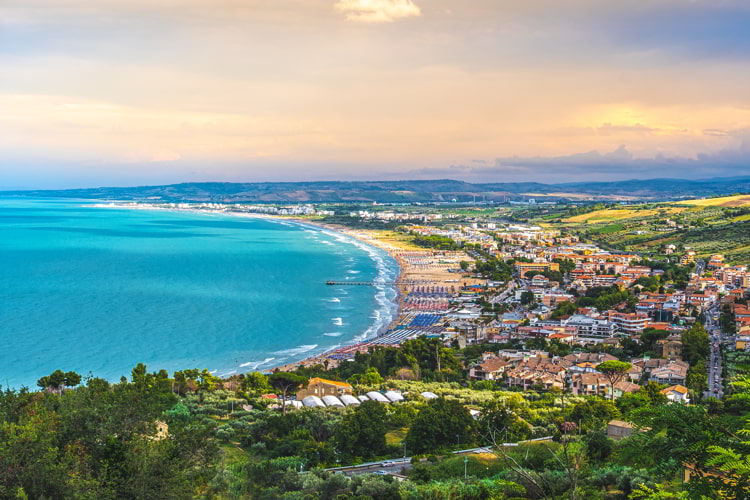Comparing My Favorite Spots On Europe’s Secret Riviera
Exploring Southern Europe’s lesser-known destinations is a special treat, and the Adriatic Coast is one such “undiscovered” locale…
This little corner of the Mediterranean Coast has been increasingly visited by backpackers and adventure and eco-tourists in the last few years, but, on the whole, this region is probably one of Europe’s last secrets.
The upper corner of the Adriatic is home to a smattering of small, young nations, including Slovenia, Montenegro, Croatia, and Albania.
On the other side of the sea is Italy’s lesser-known eastern coast, which sees far fewer tourists than Northern Italy or the famed western coast of the boot…
Italy has the lion’s share of Adriatic coastline, but the countries that share small pieces of the other side offer the same fantastic attributes at a fraction of the price.
How to begin to differentiate between them…?
Which would make the most sense for you…?
Let’s take a closer look at my top picks in this region and compare them side by side…
Montenegro
Montenegro, a tiny country in the uppermost corner of the Adriatic, is unknown by many. It’s become an up-and-coming expat destination in recent years, especially among the budget minded and adventurous traveler.
Those who have discovered this Central European destination enjoy its mild climate, beautiful scenery, low cost of living, and relaxed lifestyle.
The rugged geography of this little country provides amazing conditions for snow sports during winter and stunning hiking trails in the summer. The entire country is covered by mountains, hence its name, meaning Black Mountain.
Croatia
Croatia’s natural beauty is undeniable… pristine turquoise sea, dramatic sloping vineyards, picturesque cobblestone streets, historic churches and castles, all surrounded by fields of grapes, olives, and lavender. Undiscovered by most North Americans, it’s a hidden gem on the Adriatic Sea that offers a luxurious Mediterranean lifestyle at a fraction of the usual cost.
Croatia also boasts an attractive modern side… vibrant nightlife, trendy cafés, restaurants, and hotels. This place has something to offer just about everyone and might just be the answer to those who “want it all.”
Croatia is a popular sun holiday destination amongst Europeans for its low prices and dazzling blue coastline. It also draws crowds during the winter season to the country’s many snow resorts. A relatively new destination for North American expats, those who have settled in Croatia are enjoying a sunshine-filled retirement along the sparkling Adriatic Sea.
Istria often gets compared to Tuscany, and with good reason. The geography and the history of these two regions have much in common. But the difference is that the average person can afford Istria, where a small, renovated cottage with lookouts over a valley and vineyards, perfect for regular visits, for rental, and for retirement, costs as little as US$100,000. Keep in mind that property taxes in Croatia are zero, too.
Abruzzo, Italy
Italy is no secret to those of us who love culture, great food and wine, and the beauty of the Old World. This popular European destination is a haven for expats searching for a dreamy, sunshine-filled retirement.
The Abruzzo region, however, is the most overlooked and undervalued in Italy. You can buy here for 30% to 70% less than in Tuscany or Umbria.
But Abruzzo isn’t only affordable. It is also at least as appealing as either of Italy’s more famous regions, with both mountains and sea coast, meaning you can ski in the morning and swim in the afternoon.
Off the beaten track, it is not a usual place to spot tourists. With its diverse landscape that boasts majestic mountain ranges, rolling hills, miles of award-winning beaches, dense forests, and medieval towns, some say Abruzzo is Italy’s best-kept secret.
| Abruzzo | Croatia | Montenegro | |
| Residency | While residency here is straightforward, it comes with a high income requirement and lots of paperwork…
The self-sufficiency visa comes with a high requirement of over US$2,500 a month (exact figure fluctuates with the exchange rate). There’s also an investor option to buy a home (no minimum value) and gain residency to reside in it. |
Croatia is the more difficult place to establish residency, so may be best considered as a part-time destination…
Two potential paths are purchasing property or prepaying for rent on a property where you plan to stay. Purchasing residential property, you can get a temporary residence permit that allows you to stay for six months, then you must leave for 90 days before you can reapply. You can’t bring a spouse or dependent with this option unless they are listed as an owner of the property. If you prepay rent on a property, you can get temporary residency for up to one year—not renewable and requires you to leave the country for at least 90 days after the year is up. Neither this nor the former option is a path to permanent residency or citizenship. |
Montenegro is the hands-down winner in this category, with low income requirements and a less bureaucratic process than Italy.
The self-sufficiency visa comes with a requirement of just US$10 a day or a deposit of 3,650 euros in a local bank. The investor option here allows you to buy a home (no minimum value) and gain residency to reside in it. |
| Climate | Abruzzo has a Mediterranean climate and enjoys four mild seasons at sea level. Mountainous regions do experience harsher winters (and regular snow in winter) and towns at sea level get a lot more heat in summer than those at an elevation.
You can customize your home to the climate you’d like here—just choose an altitude that suits you year round. |
Croatia’s Adriatic coast and its islands enjoy a Mediterranean climate of mild, rainy winters and hot, dry summers.
Snowfall is rare here, but rain is common. |
Montenegro has a mild Mediterranean climate much like Abruzzo’s.
The seasons aren’t extreme at sea level, but there will be snow on the mountains in winter and you’ll sweat during the summer at sea level. Kotor has a cooler climate than the rest of the Bay of Kotor, making it an excellent option for those adverse to the heat. |
| Cost Of Living | Abruzzo offers Italy’s highest quality of life at its lowest cost.
It’s not the cheapest destination in Europe, but for the quality of life in Italy, it comes at a true bargain. Bigger cities come with hefty price tags, and they don’t offer as authentic an Italian experience as Abruzzo does. In terms of real estate, homes in the countryside here can be found at unbelievably low prices—just a few thousand or even less. (These houses usually require quite a lot of work to restore, though.) |
In recent years, Croatia has gained traction as both a holiday destination and an expat haven, resulting in an increased cost of living.
That said, prices are still much lower than in Western Europe and the States… just no longer among the cheapest found in Central Europe. Real estate in the bustling cities of Split, Dubrovnik, and Zagreb come at the highest cost. Explore outside of these areas for the best values. Shop at the local farmer’s markets, where the produce is incredibly delicious and at lower prices than in the supermarkets to make the most of your budget. |
Montenegro is one of Europe’s most affordable destinations.
Real estate prices inland are low, even in the capital, Podgorica. Property prices rise along the coastline, especially in popular tourist destinations such as Porto Montenegro, a port filled with superyachts belonging to Europe’s elite. Day-to-day living in Montenegro is a lot cheaper than in the States or Canada. Groceries are affordable, as are public transportation costs and even health care. |
| Health Care | Italy has the eighth best health care system in the world according to the WHO, and Abruzzo boasts excellent care across the region.
Wait times will be long in the public system, and many here support the public system with partial private care to avoid wait times. You might have difficulty finding English-speaking doctors, though. Enroll in the national health service after 5 years of residency and have most care subsidized. |
The public health care system in Croatia is run to a high standard, yet as with most public health systems, long wait times can be an issue. Opt for private health insurance to get around this.
Private clinics in Croatia are world-class, and you will easily find an English-speaking doctor here. When you become a resident in Croatia, you will need to start paying into the Croatian Health Insurance Fund, which gives full access to the public health service. Once in the system, all care is heavily subsidized. |
Being a young country, certain public services are still developing, including health care, which falls behind European standards.
The public health care system is inadequately funded, resulting in poor quality of care, long wait times, and a lack of trained professionals. Expats should invest in quality international health care insurance. This will guarantee access to the high-quality private medical clinics in Montenegro, where doctors speak English and the facilities are modern. |








